K. J. Ray Liu
Experience Paper: Scaling WiFi Sensing to Millions of Commodity Devices for Ubiquitous Home Monitoring
Jun 04, 2025Abstract:WiFi-based home monitoring has emerged as a compelling alternative to traditional camera- and sensor-based solutions, offering wide coverage with minimal intrusion by leveraging existing wireless infrastructure. This paper presents key insights and lessons learned from developing and deploying a large-scale WiFi sensing solution, currently operational across over 10 million commodity off-the-shelf routers and 100 million smart bulbs worldwide. Through this extensive deployment, we identify four real-world challenges that hinder the practical adoption of prior research: 1) Non-human movements (e.g., pets) frequently trigger false positives; 2) Low-cost WiFi chipsets and heterogeneous hardware introduce inconsistencies in channel state information (CSI) measurements; 3) Motion interference in multi-user environments complicates occupant differentiation; 4) Computational constraints on edge devices and limited cloud transmission impede real-time processing. To address these challenges, we present a practical and scalable system, validated through comprehensive two-year evaluations involving 280 edge devices, across 16 scenarios, and over 4 million motion samples. Our solutions achieve an accuracy of 92.61% in diverse real-world homes while reducing false alarms due to non-human movements from 63.1% to 8.4% and lowering CSI transmission overhead by 99.72%. Notably, our system integrates sensing and communication, supporting simultaneous WiFi sensing and data transmission over home WiFi networks. While focused on home monitoring, our findings and strategies generalize to various WiFi sensing applications. By bridging the gaps between theoretical research and commercial deployment, this work offers practical insights for scaling WiFi sensing in real-world environments.
CSI-Bench: A Large-Scale In-the-Wild Dataset for Multi-task WiFi Sensing
May 28, 2025
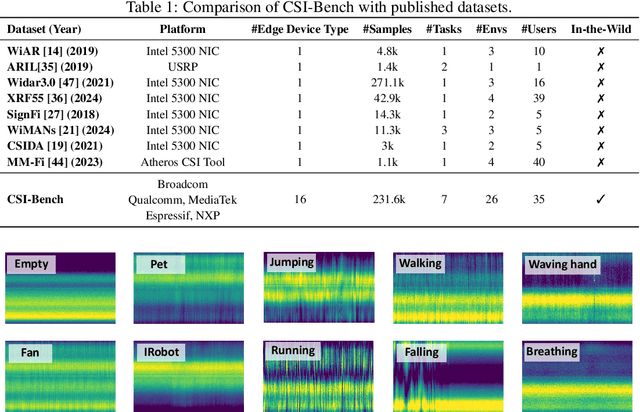

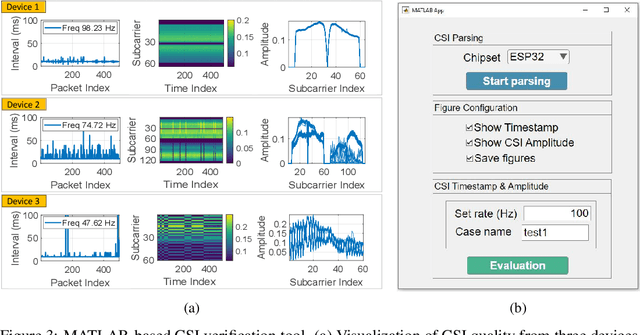
Abstract:WiFi sensing has emerged as a compelling contactless modality for human activity monitoring by capturing fine-grained variations in Channel State Information (CSI). Its ability to operate continuously and non-intrusively while preserving user privacy makes it particularly suitable for health monitoring. However, existing WiFi sensing systems struggle to generalize in real-world settings, largely due to datasets collected in controlled environments with homogeneous hardware and fragmented, session-based recordings that fail to reflect continuous daily activity. We present CSI-Bench, a large-scale, in-the-wild benchmark dataset collected using commercial WiFi edge devices across 26 diverse indoor environments with 35 real users. Spanning over 461 hours of effective data, CSI-Bench captures realistic signal variability under natural conditions. It includes task-specific datasets for fall detection, breathing monitoring, localization, and motion source recognition, as well as a co-labeled multitask dataset with joint annotations for user identity, activity, and proximity. To support the development of robust and generalizable models, CSI-Bench provides standardized evaluation splits and baseline results for both single-task and multi-task learning. CSI-Bench offers a foundation for scalable, privacy-preserving WiFi sensing systems in health and broader human-centric applications.
DeepCPD: Deep Learning Based In-Car Child Presence Detection Using WiFi
May 13, 2025Abstract:Child presence detection (CPD) is a vital technology for vehicles to prevent heat-related fatalities or injuries by detecting the presence of a child left unattended. Regulatory agencies around the world are planning to mandate CPD systems in the near future. However, existing solutions have limitations in terms of accuracy, coverage, and additional device requirements. While WiFi-based solutions can overcome the limitations, existing approaches struggle to reliably distinguish between adult and child presence, leading to frequent false alarms, and are often sensitive to environmental variations. In this paper, we present DeepCPD, a novel deep learning framework designed for accurate child presence detection in smart vehicles. DeepCPD utilizes an environment-independent feature-the auto-correlation function (ACF) derived from WiFi channel state information (CSI)-to capture human-related signatures while mitigating environmental distortions. A Transformer-based architecture, followed by a multilayer perceptron (MLP), is employed to differentiate adults from children by modeling motion patterns and subtle body size differences. To address the limited availability of in-vehicle child and adult data, we introduce a two-stage learning strategy that significantly enhances model generalization. Extensive experiments conducted across more than 25 car models and over 500 hours of data collection demonstrate that DeepCPD achieves an overall accuracy of 92.86%, outperforming a CNN baseline by a substantial margin (79.55%). Additionally, the model attains a 91.45% detection rate for children while maintaining a low false alarm rate of 6.14%.
Robust Proximity Detection using On-Device Gait Monitoring
Apr 30, 2024Abstract:Proximity detection in indoor environments based on WiFi signals has gained significant attention in recent years. Existing works rely on the dynamic signal reflections and their extracted features are dependent on motion strength. To address this issue, we design a robust WiFi-based proximity detector by considering gait monitoring. Specifically, we propose a gait score that accurately evaluates gait presence by leveraging the speed estimated from the autocorrelation function (ACF) of channel state information (CSI). By combining this gait score with a proximity feature, our approach effectively distinguishes different transition patterns, enabling more reliable proximity detection. In addition, to enhance the stability of the detection process, we employ a state machine and extract temporal information, ensuring continuous proximity detection even during subtle movements. Extensive experiments conducted in different environments demonstrate an overall detection rate of 92.5% and a low false alarm rate of 1.12% with a delay of 0.825s.
mmID: High-Resolution mmWave Imaging for Human Identification
Feb 01, 2024



Abstract:Achieving accurate human identification through RF imaging has been a persistent challenge, primarily attributed to the limited aperture size and its consequent impact on imaging resolution. The existing imaging solution enables tasks such as pose estimation, activity recognition, and human tracking based on deep neural networks by estimating skeleton joints. In contrast to estimating joints, this paper proposes to improve imaging resolution by estimating the human figure as a whole using conditional generative adversarial networks (cGAN). In order to reduce training complexity, we use an estimated spatial spectrum using the MUltiple SIgnal Classification (MUSIC) algorithm as input to the cGAN. Our system generates environmentally independent, high-resolution images that can extract unique physical features useful for human identification. We use a simple convolution layers-based classification network to obtain the final identification result. From the experimental results, we show that resolution of the image produced by our trained generator is high enough to enable human identification. Our finding indicates high-resolution accuracy with 5% mean silhouette difference to the Kinect device. Extensive experiments in different environments on multiple testers demonstrate that our system can achieve 93% overall test accuracy in unseen environments for static human target identification.
RadioSES: mmWave-Based Audioradio Speech Enhancement and Separation System
Apr 14, 2022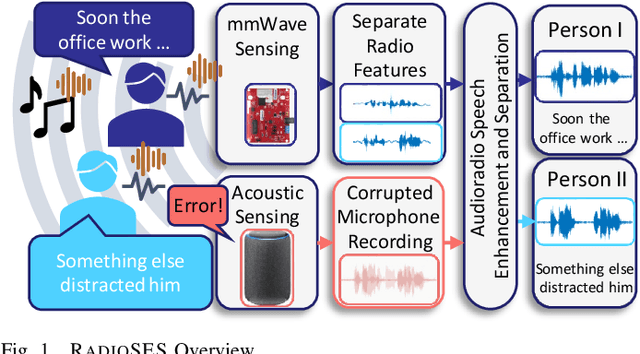
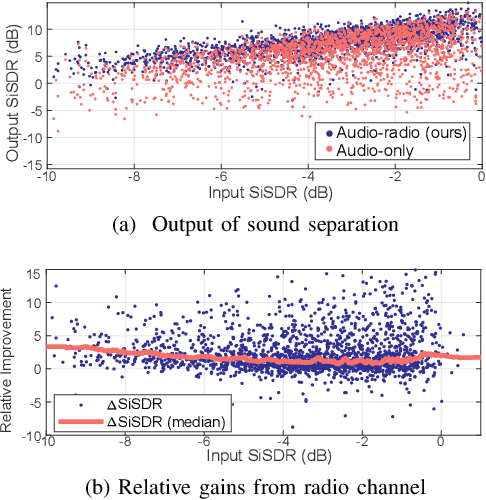

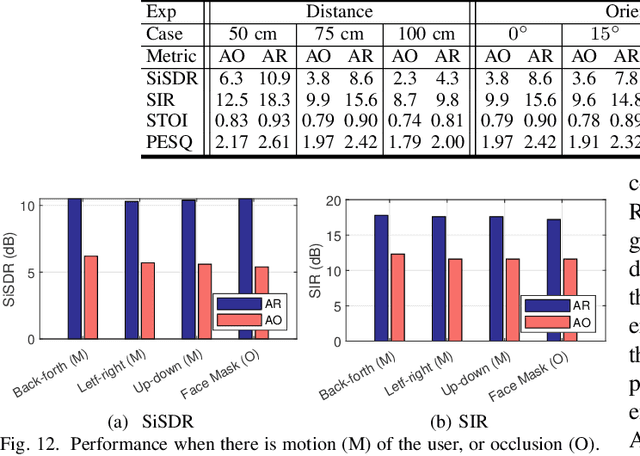
Abstract:Speech enhancement and separation have been a long-standing problem, especially with the recent advances using a single microphone. Although microphones perform well in constrained settings, their performance for speech separation decreases in noisy conditions. In this work, we propose RadioSES, an audioradio speech enhancement and separation system that overcomes inherent problems in audio-only systems. By fusing a complementary radio modality, RadioSES can estimate the number of speakers, solve source association problem, separate and enhance noisy mixture speeches, and improve both intelligibility and perceptual quality. We perform millimeter-wave sensing to detect and localize speakers, and introduce an audioradio deep learning framework to fuse the separate radio features with the mixed audio features. Extensive experiments using commercial off-the-shelf devices show that RadioSES outperforms a variety of state-of-the-art baselines, with consistent performance gains in different environmental settings. Compared with the audiovisual methods, RadioSES provides similar improvements (e.g., ~3 dB gains in SiSDR), along with the benefits of lower computational complexity and being less privacy concerning.
RadioMic: Sound Sensing via mmWave Signals
Aug 06, 2021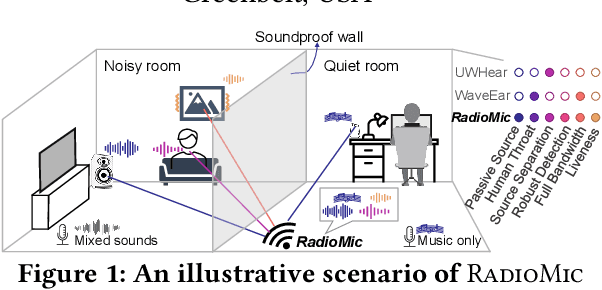
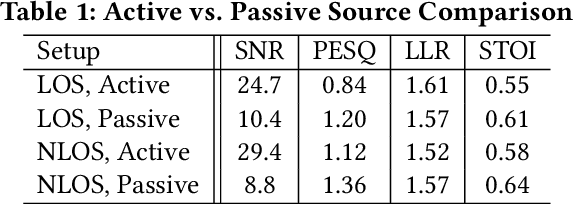
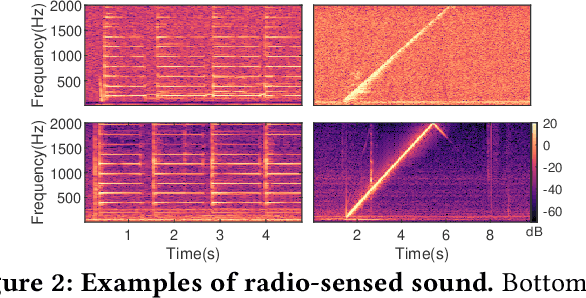

Abstract:Voice interfaces has become an integral part of our lives, with the proliferation of smart devices. Today, IoT devices mainly rely on microphones to sense sound. Microphones, however, have fundamental limitations, such as weak source separation, limited range in the presence of acoustic insulation, and being prone to multiple side-channel attacks. In this paper, we propose RadioMic, a radio-based sound sensing system to mitigate these issues and enrich sound applications. RadioMic constructs sound based on tiny vibrations on active sources (e.g., a speaker or human throat) or object surfaces (e.g., paper bag), and can work through walls, even a soundproof one. To convert the extremely weak sound vibration in the radio signals into sound signals, RadioMic introduces radio acoustics, and presents training-free approaches for robust sound detection and high-fidelity sound recovery. It then exploits a neural network to further enhance the recovered sound by expanding the recoverable frequencies and reducing the noises. RadioMic translates massive online audios to synthesized data to train the network, and thus minimizes the need of RF data. We thoroughly evaluate RadioMic under different scenarios using a commodity mmWave radar. The results show RadioMic outperforms the state-of-the-art systems significantly. We believe RadioMic provides new horizons for sound sensing and inspires attractive sensing capabilities of mmWave sensing devices
Distributed Adaptive Networks: A Graphical Evolutionary Game-Theoretic View
Sep 11, 2013



Abstract:Distributed adaptive filtering has been considered as an effective approach for data processing and estimation over distributed networks. Most existing distributed adaptive filtering algorithms focus on designing different information diffusion rules, regardless of the nature evolutionary characteristic of a distributed network. In this paper, we study the adaptive network from the game theoretic perspective and formulate the distributed adaptive filtering problem as a graphical evolutionary game. With the proposed formulation, the nodes in the network are regarded as players and the local combiner of estimation information from different neighbors is regarded as different strategies selection. We show that this graphical evolutionary game framework is very general and can unify the existing adaptive network algorithms. Based on this framework, as examples, we further propose two error-aware adaptive filtering algorithms. Moreover, we use graphical evolutionary game theory to analyze the information diffusion process over the adaptive networks and evolutionarily stable strategy of the system. Finally, simulation results are shown to verify the effectiveness of our analysis and proposed methods.
Chinese Restaurant Game - Part I: Theory of Learning with Negative Network Externality
Feb 13, 2012



Abstract:In a social network, agents are intelligent and have the capability to make decisions to maximize their utilities. They can either make wise decisions by taking advantages of other agents' experiences through learning, or make decisions earlier to avoid competitions from huge crowds. Both these two effects, social learning and negative network externality, play important roles in the decision process of an agent. While there are existing works on either social learning or negative network externality, a general study on considering both these two contradictory effects is still limited. We find that the Chinese restaurant process, a popular random process, provides a well-defined structure to model the decision process of an agent under these two effects. By introducing the strategic behavior into the non-strategic Chinese restaurant process, in Part I of this two-part paper, we propose a new game, called Chinese Restaurant Game, to formulate the social learning problem with negative network externality. Through analyzing the proposed Chinese restaurant game, we derive the optimal strategy of each agent and provide a recursive method to achieve the optimal strategy. How social learning and negative network externality influence each other under various settings is also studied through simulations.
Chinese Restaurant Game - Part II: Applications to Wireless Networking, Cloud Computing, and Online Social Networking
Dec 15, 2011



Abstract:In Part I of this two-part paper [1], we proposed a new game, called Chinese restaurant game, to analyze the social learning problem with negative network externality. The best responses of agents in the Chinese restaurant game with imperfect signals are constructed through a recursive method, and the influence of both learning and network externality on the utilities of agents is studied. In Part II of this two-part paper, we illustrate three applications of Chinese restaurant game in wireless networking, cloud computing, and online social networking. For each application, we formulate the corresponding problem as a Chinese restaurant game and analyze how agents learn and make strategic decisions in the problem. The proposed method is compared with four common-sense methods in terms of agents' utilities and the overall system performance through simulations. We find that the proposed Chinese restaurant game theoretic approach indeed helps agents make better decisions and improves the overall system performance. Furthermore, agents with different decision orders have different advantages in terms of their utilities, which also verifies the conclusions drawn in Part I of this two-part paper.
 Add to Chrome
Add to Chrome Add to Firefox
Add to Firefox Add to Edge
Add to Edge